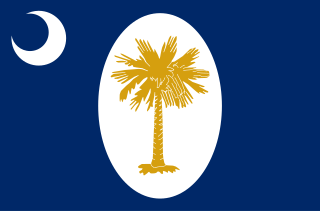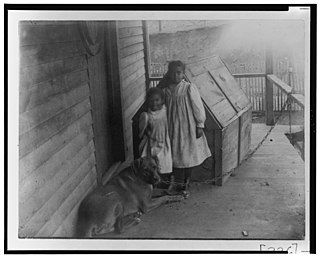Related Research Articles

York County is a county on the north central border in the U.S. state of South Carolina. As of the 2020 census, the population was 282,090, making it the seventh-most populous county in the state. Its county seat is the city of York, and its most populous community is Rock Hill. The county is served by one Interstate Highway, Interstate 77.

Clinton is a city in Laurens County, South Carolina, United States. The population was 8,490 as of the 2010 census. It is part of the Greenville–Mauldin–Easley Metropolitan Statistical Area in upstate South Carolina. Clinton is the home of Presbyterian College.

Edisto Island is one of South Carolina's Sea Islands, the larger part of which lies in Charleston County, with its southern tip in Colleton County. Edisto Beach is in Colleton County, and the Charleston County part of the island is unincorporated.

The South Carolina House of Representatives is the lower house of the South Carolina General Assembly. It consists of 124 representatives elected to two-year terms at the same time as U.S. congressional elections.

The Broad River is a principal tributary of the Congaree River, about 150 miles (240 km) long, in western North Carolina and northern South Carolina in the United States. Via the Congaree, it is part of the watershed of the Santee River, which flows to the Atlantic Ocean.

The South Carolina Republican Party (SCGOP) is the state affiliate of the national Republican Party in South Carolina. It is one of two major political parties in the state, along with the South Carolina Democratic Party, and is the dominant party. Incumbent governor Henry McMaster, as well as senators Tim Scott and Lindsey Graham, are members of the Republican party. Graham has served since January 3, 2003, having been elected in 2002 and re-elected in 2008, 2014, and 2020; Tim Scott was appointed in 2013 by then-governor Nikki Haley, who is also a Republican.

South Carolina was the first state to secede from the Union in December 1860, and was one of the founding member states of the Confederacy in February 1861. The bombardment of the beleaguered U.S. garrison at Fort Sumter in Charleston Harbor on April 12, 1861, is generally recognized as the first military engagement of the war. The retaking of Charleston in February 1865, and raising the flag again at Fort Sumter, was used for the Union symbol of victory.
Rantowles, South Carolina is an unincorporated community in what is now Hollywood, and Ravenel, South Carolina, near the Stono River and Stono Swamp. Rantowles Creek runs through the area.

Thomas Williamson Means was a settler of Hanging Rock, Ohio, and a native of South Carolina. Together with his brother Hugh he became notable in Ashland, Kentucky, after he built the Buena Vista Furnace and became a director of the Kentucky Coal, Iron & Manufacturing Company. He was also the father of Ashland Mayor John Means. Means owned furnaces in Alabama, Kentucky, Ohio, and Virginia.

African-American Georgians are residents of the U.S. state of Georgia who are of African American ancestry. As of the 2010 U.S. Census, African Americans were 31.2% of the state's population. Georgia has the second largest African American population in the United States following Texas. Georgia also has a gullah community. African slaves were brought to Georgia during the slave trade.

Black South Carolinians are residents of the state of South Carolina who are of African American ancestry. This article examines South Carolina's history with an emphasis on the lives, status, and contributions of African Americans. Enslaved Africans first arrived in the region in 1526, and the institution of slavery remained until the end of the Civil War in 1865. Until slavery's abolition, the free black population of South Carolina never exceeded 2%. Beginning during the Reconstruction Era, African Americans were elected to political offices in large numbers, leading to South Carolina's first majority-black government. Toward the end of the 1870s however, the Democratic Party regained power and passed laws aimed at disenfranchising African Americans, including the denial of the right to vote. Between the 1870s and 1960s, African Americans and whites lived segregated lives; people of color and whites were not allowed to attend the same schools or share public facilities. African Americans were treated as second-class citizens leading to the civil rights movement in the 1960s. In modern America, African Americans constitute 22% of the state's legislature, and in 2014, the state's first African American U.S. Senator since Reconstruction, Tim Scott, was elected. In 2015, the Confederate flag was removed from the South Carolina Statehouse after the Charleston church shooting.

South Carolina Highway 66 (SC 66) is a 18.550-mile (29.853 km) primary state highway in the state of South Carolina. It serves to connect the community of Joanna with nearby SC 56 and the town of Whitmire.
Charles McDuffie Wilder was a public official in South Carolina who was appointed postmaster by U.S. President Ulysses S. Grant and was a city councilor in Columbia, South Carolina. He established himself as a carpenter. He served as a member of the South Carolina General Assembly.
Henry Johnson Maxwell was a lawyer, soldier in the Union Army, state senator, and postmaster in South Carolina.
John Hopkins was Lieutenant Governor of South Carolina from December 1806 until 1808.
James Daniel Lynch was an American lawyer, farmer, judge, poet, and writer. His poem "Columbia Saluting the Nations" was chosen as the official salutation for the Chicago World's Fair in 1893. He lived in Mississippi. He served in the Confederate Army. He was an opponent of Reconstruction.

Judith DuBose was a Colonial American heiress. Born into a prominent French Huguenot family of planters, DuBose married Joseph Wragg, a prominent slave trader in British North America.

Styles Linton Hutchins was an attorney, politician, and activist in South Carolina, Georgia, and Tennessee between 1877 and 1906. Hutchins was among the last African Americans to graduate from the University of South Carolina School of Law in the brief window during Reconstruction when the school was open to Black students and the first Black attorney admitted to practice in Georgia. He practiced law and participated in Georgia and Tennessee politics. He served a single term (1887-1888) in the Tennessee General Assembly as one of its last Black members before an era of entrenched white supremacist policies that lasted until 1965, and advocated for the interests of African Americans. He called for reparations and attempted to identify or create a separate homeland for Blacks. He was a member of the defense team in the 1906 appeal on civil rights grounds by Ed Johnson of a conviction of rape, a case which reached the Supreme Court before it was halted by Johnson's murder by lynching in Chattanooga, Tennessee.

Barnwell High School is a public high school in Barnwell, South Carolina. It has about 625 students. The Warhorse is the school's mascot.
References
- ↑ U.S. Geological Survey Geographic Names Information System: Santuc, South Carolina
- ↑ Times, Union (June 21, 2018). "Union County Dragway reopens". Union Daily Times.
- ↑ Times, Union (August 11, 2018). "'Providing an exemplary service'". Union Daily Times.
- ↑ Politics, Kings County (February 24, 2020). "The Jim Crow Era: A Solemn Roll Call Of Those Brutally Murdered".
- ↑ Raper, Arthur F. (March 15, 2012). The Tragedy of Lynching. Courier Corporation. ISBN 9780486149196 – via Google Books.
- ↑ Simon, Bryant (November 9, 2000). A Fabric of Defeat: The Politics of South Carolina Millhands, 1910-1948. Univ of North Carolina Press. ISBN 9780807864494 – via Google Books.
- ↑ Office, South Carolina Comptroller General's (June 10, 1900). "Report of the Comptroller General" – via Google Books.
- ↑ Kibler, James E. (June 10, 1998). Our Fathers' Fields: A Southern Story. Univ of South Carolina Press. ISBN 9781570032141 – via Google Books.
- ↑ Gee, Wilson Parham (June 10, 1933). "The Qualitative Nature of Rural Depopulation in Santuc Township, South Carolina, 1900-1930". South Carolina Agricultural Experiment Station – via Google Books.
- ↑ "Qualitative nature o". June 10, 1933 – via Google Books.
- ↑ "Eison Lyles, Santuc, South Carolina, January 20, 1938". Library of Congress.
- ↑ Administration, Work Projects. Slave Narratives: Interviews with Former Slaves South Carolina Narratives—Part 3. Lulu.com. ISBN 9781300533733 – via Google Books.
- ↑ "Official Series Description - SANTUC Series". soilseries.sc.egov.usda.gov.
- ↑ "Seven Springs House (1810) Santuc, S.C. No. 4". digital.tcl.sc.edu. Retrieved November 22, 2021.
34°38′03.4″N81°31′33.5″W / 34.634278°N 81.525972°W
